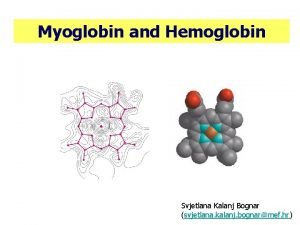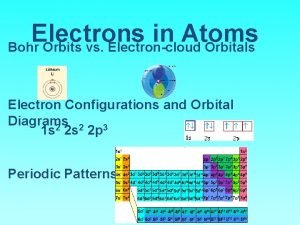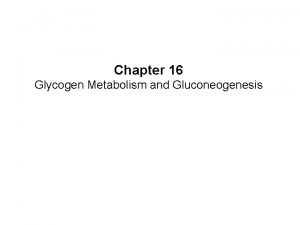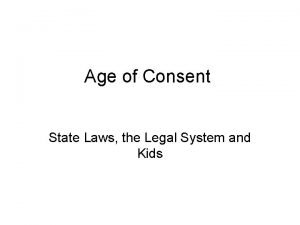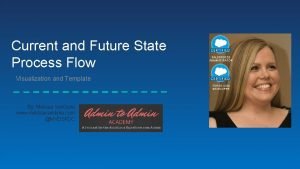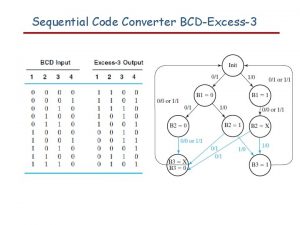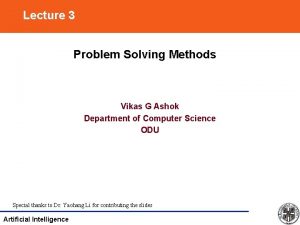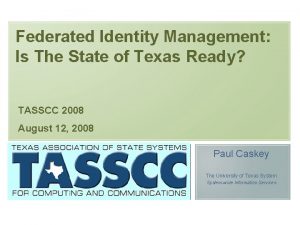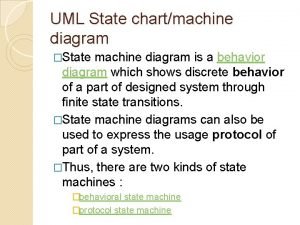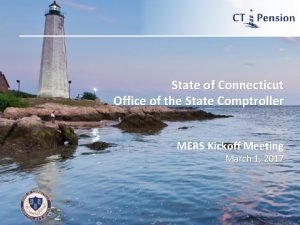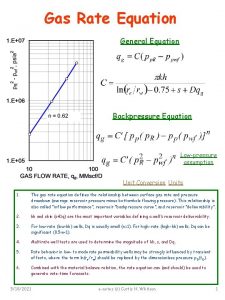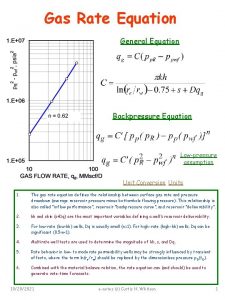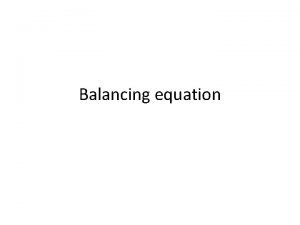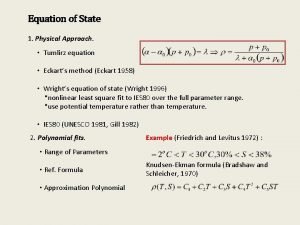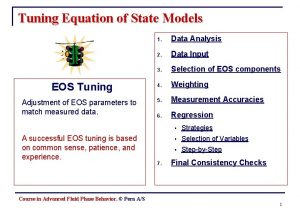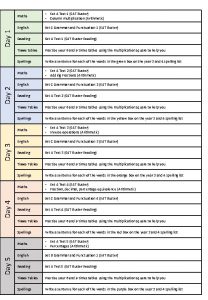Day 2 Part 2 Equation of State Models










































- Slides: 42

Day 2 – Part 2: Equation of State Models. § § § Cubic Equation of State models. Two-phase flash calculations (VLE). Stability Analysis Saturation Pressure Calculations. Gradient Calculations Introduction to PVT Simulators Exercise 2 -1 Course in Advanced Fluid Phase Behavior. © Pera A/S 1

Equation of State Calculations Problem Definition Fluid Mixture ? § Equation of state models (EOS) are simple equations relating pressure, volume and temperature. § An EOS model accurately describes the multi-phase thermodynamic equilibrium of a multi-component system, as well as the PVT properties of any given phase. § Combined with a mass-balance equation (Rachford-Rice) the EOS model gives the equilibrium phase split of a multi-component fluid mixture. Vapor Liquid (zi, p, T) Equation of State Models (Fv, xi, yi) Given an overall fluid composition at given pressure & temperature: § Determine relative amount of equilibrium oil and gas. § Determine equilibrium oil and gas compositions (K-values). § Determine essential fluid phase properties. Course in Advanced Fluid Phase Behavior. © Pera A/S 2

EOS Applications § Reservoir simulation § Generation of black-oil tables § Compositional simulations § § Gas injection. § Near critical fluids. Conversion from black-oil to compositional. Pipeline calculations § § § Pressure loss, liquid dropout, etc. Surface process calculations. Course in Advanced Fluid Phase Behavior. © Pera A/S 3

Cubic Equation of State Models General 2 -parameter cubic EOS The parameters and are fixed numbers, but varies in the various EOS formulations. The constants a and b are defined for pure components by the critical criteria: In its simplest form, the constants a and b are only function of reduced- pressure and temperature (pr=p/pc, Tr=T/Tc). The cubic EOS equation is generally expressed in terms of Z-factor (v=ZRT/p) where the constants C 0, C 1, and C 2 are given by a and b. An EOS is extended to multi-component mixtures by applying appropriate Mixing Rules to its parameters, and introducing binary interaction coefficients (BIPs) to improve the vapor-liquid equilibrium (VLE). Continued Course in Advanced Fluid Phase Behavior. © Pera A/S 4

Cubic Equation of State Models, cont. General 2 -parameter cubic EOS § With any cubic EOS, the typically poor liquid density predictions can be greatly improved by Volume Translation, which should therefore always be used. § The Vapor-Liquid Equilibrium (VLE ) of a fluid system is determined by its Thermodynamic Properties, which can be derived analytically from any cubic EOS. § Viscosities are usually calculated using correlations. § The EOS combined with material balance equation forms the basis for two-phase flash calculations. The parameters and are common for all components, but are different in the various EOS model formulations. Some of the most commonly used EOS models are: § Van der Waals EOS § Soave-Redlich-Kwong EOS § Peng-Robinson EOS Course in Advanced Fluid Phase Behavior. © Pera A/S 5

Van der Waals’ “Critical Criteria” General cubic EOS form Criteria to determine a and b for single components: Course in Advanced Fluid Phase Behavior. © Pera A/S 6

Volume Translation (Volume Shift) General 2 -parameter cubic EOS Problem: The prediction for v is usually quite accurate for gases (when v is large), but can easily be 10% in error for liquids (when v is small). Solution: Subtract a component and temperature dependent molar volume correction, c, from v. General 3 -parameter cubic EOS For a given component, c is usually expressed as sb, where s is a dimensionless parameter less than 1 (typically between 0. 2 and -0. 2). Note that c can be a linear function of composition and an arbitrary function of temperature without affecting any equilibrium calculations (aside from the phase densities). Course in Advanced Fluid Phase Behavior. © Pera A/S 7

Multi-Component Properties Mixing Rules Course in Advanced Fluid Phase Behavior. © Pera A/S 8

Vapor-Liquid Equilibrium (VLE) § § Thermodynamic Equilibrium occurs when the system’s Gibbs Free Energy is at its minimum. For a multi-component, multi-phase system, the Gibbs Free Energy is the mole-weighted sum of the Chemical Potentials of all components in all phases Gibbs Free Energy § A component’s chemical potential is determined by depth, temperature and fugacity. Chemical Potential § At uniform depth, equilibrium occurs only if the fugacity of any given component is the same in all phases. Continued Course in Advanced Fluid Phase Behavior. © Pera A/S 9

Vapor-Liquid Equilibrium (VLE), cont. § Within a given phase, a component’s fugacity is its Partial Pressure multiplied by a Fugacity Coefficient, which is given by the relationships between temperature, pressure, volume and composition Fugacity § The fugacities can easily be calculated by the EOS, and are given by the Z-factor, and the particular EOS constants A and B § Therefore, an EOS can determine the multi-phase thermodynamic equilibrium of a multi-component isothermal system, as well as the PVT behavior of any given phase. Course in Advanced Fluid Phase Behavior. © Pera A/S 10

Fugacities for Different EOS Models Peng-Robinson Soave-Redlich-Kwong Course in Advanced Fluid Phase Behavior. © Pera A/S 11

Lorentz-Bray-Clark Viscosity Calculations Course in Advanced Fluid Phase Behavior. © Pera A/S 12

Two-Phase Flash Calculations Problem Definition Fluid Mixture ? Vapor Simplified Algorithm: 1. Estimate initial K-Values. 2. Calculate equilibrium phase compositions xi and yi , by solving Rachford-Rice material balance. 3. Calculate Z-factors and fugacities for each phase using, the EOS model. 4. Check equilibrium constraint: Liquid Given an overall fluid composition at given pressure & temperature: § § Determine relative amount of equilibrium oil and gas. Determine equilibrium oil and gas compositions. a) Stop if convergence is reached b) If convergence is not reached, update K-values and re-do step 2 -3 Course in Advanced Fluid Phase Behavior. © Pera A/S 13

Estimating K-Values Wilson’s K-Value Equation: § Can be used for initial estimate for the two-phase flash. § Not accurate for high pressures. § Many iterations might be needed before convergence, and potentially the two-phase flash might even converge to a false solution. § Simulation models use estimated K-values based on a converged flash of the same liquid at related temperature and pressures, or Kvalue estimate from a stability-test. Course in Advanced Fluid Phase Behavior. © Pera A/S 14

Rachford-Rice Material Balance (1) (3) (2) (4) Rachford-Rice Equation Course in Advanced Fluid Phase Behavior. © Pera A/S 15

Solving Rachford-Rice Equation § With composition, zi, and K-values, Ki, known, the only unknown is Fv (vapor mole fraction. ) § The only physical solution for Fv lies in the region given by: . Course in Advanced Fluid Phase Behavior. © Pera A/S 16

Solving Rachford-Rice Equation, cont. § The Rachford-Rice equation is usually solved for Fv using a Newton Raphson solution algorithm § After solving for Fv, the phase compositions are calculated from the material-balance equations . Course in Advanced Fluid Phase Behavior. © Pera A/S 17

Two-Phase Equilibrium Thermodynamic Equilibrium § Vapor yi Liquid xi Ki=yi/xi Updating K-values § If convergence is not reached, the K-values must be updated by successive substitution The chemical potential of each component in each phase are equal Convergence criteria: Course in Advanced Fluid Phase Behavior. © Pera A/S 18

Stability Analysis Problem Definition ? Fluid Mixture ? One of the most difficult aspects of VLE calculations is to determine whether a fluid is stable at given conditions, or if it is unstable and will split into several phases. § Traditionally this questions has been solved by conducting a twophase flash or saturation pressure calculation. However this approach is slow and not always reliable. § More robust approaches are based on Gibbs Tangent Plane Criteria. Single phase P 1 P 2 ? § P 1 P 2 P 3 Given an overall fluid composition, pressure and temperature: § Will the fluid mixture split into two (or more) phases? Course in Advanced Fluid Phase Behavior. © Pera A/S 19

Stability Analysis - Gibbs Tangent Plane Criteria The thermodynamic equilibrium of a § fluid is determined by the condition at which the Gibbs energy is at it’s minimum for all possible combination of phases and component distributions. Problem formulation: Is Gz < Gmix for all possible phase combinations? Gibbs energy, homogeneous phase: § For a binary mixture the tangentplane criterion can be interpreted graphically: Gibbs energy, mixture (two-phase): § Michelsen has proposed a fast and robust algorithm based on the tangent plane criterion (Michelsen’s stability test). Course in Advanced Fluid Phase Behavior. © Pera A/S 20

Graphical Stability Analysis (from Baker et. al) False solution Two-phase V-L 1 Three-phase V-L 1 -L 2 Two-phase V-L 2, L 1 -L 2 Course in Advanced Fluid Phase Behavior. © Pera A/S 21

Michelsen’s Stability Test Algorithm § § § The method is based on detection of possible “second phase” compositions with Gibbs energy tangent planes parallel to the mixture composition. Conducts two separate tests; one assuming the second phase is vapor -like, and the other assuming a liquid -like second phase. Simplified Algorithm: 1. Calculate mixture fugacities fgi (with multiple Z-roots, select the solution with the lowest g). 2. Estimate initial K-values (Wilson). 3. Calculate second phase mole numbers: 4. Calculate sum of mole numbers: Michelsen shows that the criteria for a parallel tangent plane is given by: Course in Advanced Fluid Phase Behavior. © Pera A/S 22

Michelsen’s Stability Test Algorithm, cont. 5. 6. 7. Normalize mole numbers to get second-phase compositions: 8. Check for convergence: 9. If convergence not achieved, update K-values: 10. Check for trivial solution: 11. If trivial solution not indicated, go to step 3 for another iteration. Interpretation of results Calculate second-phase fugacities using the EOS model. Calculate fugacity correction factors for updating the K-values: Course in Advanced Fluid Phase Behavior. © Pera A/S 23

Michelsen’s Stability Test - Interpretation Course in Advanced Fluid Phase Behavior. © Pera A/S 24

Saturation Pressure Calculations Problem Definition Liquid Psat = ? A simple method for determining the saturation pressure is to do a iterative search in pressure until the vapor fraction Fv=0 (bubblepoint) or Fv=1 (dew-point). This method however is slow! § A faster approach is to apply the stability test to determine the saturation pressure. Gas Given an overall fluid composition at given temperature: § § Determine pressure where the mixture is in equilibrium with an infinitesimal amount of the incipient phase. Algorithm Course in Advanced Fluid Phase Behavior. © Pera A/S 25

Saturation Pressure Algorithm § § In terms of stability analysis, finding a saturation pressure corresponds to finding a second-phase with a tangent plane equal to the mixture tangent plane (zero distance between them). Simplified Algorithm: 1. Guess saturation type: bubblepoint or dew-point (guess will not affect pressure convergence, only the final K-values). This corresponds to the sum incipient phase mole numbers equal to unity: 2. Guess starting pressure, p* 3. Perform Michelsen’s stability test at p* a) If a stable solution is found, p* represent the upper bound. Return to step-1 and guess a lower pressure. b) If an unstable solution is found, this represents the lower bound for the upper curve of the phase envelope. where Course in Advanced Fluid Phase Behavior. © Pera A/S 26

Saturation Pressure Algorithm, cont. 4. 5. Use K-values from stability test to calculate incipient-phase mole numbers (if multiple-solutions where found, use the one with the biggest mole number sum): 6. Update incipient-phase mole numbers using fugacity correction factors: 7. Update saturation pressure Calculate incipient-phase fugacities using the EOS model, and fugacity-ratio correction factors: Course in Advanced Fluid Phase Behavior. © Pera A/S 27

Saturation Pressure Algorithm, cont. 7. (cont. ) If searching for an upper saturation pressure, the new estimate must be higher than p*, otherwise use a higher estimate of p* and go to step-1. 8. Check for convergence, the following two criteria is suggested by Zick: 9. Check for trivial solution using: 10. (a) If convergence is not achieved, go to step-4. (b) If convergence is achieved, determine saturation type by comparing mole fraction of the heaviest components in the mixture and incipient phase. (More heavy components in incipient phase indicates bubble-point, less indicates dew-point). Course in Advanced Fluid Phase Behavior. © Pera A/S 28

PVT Simulators - Introduction Equation of State Calculations Input Output • Component description (critical properties) • Equilibrium calculations (phase split & compositions) • Fluid composition PVT Simulator • Thermodynamic conditions (p, T) • Fluid PVT properties (e. g. density, viscosity, etc. ) Course in Advanced Fluid Phase Behavior. © Pera A/S 29

PVT Simulators - Introduction Generation of Fluid Characterizations Input • Component description (critical properties) Result • Fluid compositions • PVT Measurements: üDLE üCCE üCVD PVT Simulator üSEP • EOS characterization model (compositional model). • Black oil PVT models (black oil tables). üVISCOSITY Tuning (Regression) • Updated component properties. • Modified compositions. Course in Advanced Fluid Phase Behavior. © Pera A/S 30

Phaze. Comp – State of the Art, by Zick Technologies § Building and tuning multiple EOS fluid characterizations simultaneously. § Manipulating fluid compositions. § Simulating user-defined experiments. § Matching user-defined data. § Predicting MMPs and MMEs. § Detecting three-phase equilibria. § Gravitational segregation experiments. § User-defined process calculations. § Black-oil table generation. Course in Advanced Fluid Phase Behavior. © Pera A/S 31

The Phaze. Comp Approach § Virtual phase behavior laboratory. § User-programmed sequence of events. § Results from any calculation may be carried over to any other calculation. § Almost any parameter or independent variable can be modified to improve the predictions of experimental data. Course in Advanced Fluid Phase Behavior. © Pera A/S 32

Phaze. Comp – Typical Sequence of Events § Build a fluid characterization. § Define regression variables. § Assign temperatures, pressures, and any number of fluid compositions. § Perform calculations and experiments. § Repeat the above steps as necessary. § Cycle through instructions, regressing on variables to optimize predictions. Course in Advanced Fluid Phase Behavior. © Pera A/S 33

Phaze. Comp – Building Characterizations § Input tables of components and their non-default properties. § Initialize certain missing properties from a base characterization, a component library, and/or a Gamma distribution. § Apply regression variables to properties. § Apply defaults and correlations to define any remaining undefined properties. Course in Advanced Fluid Phase Behavior. © Pera A/S 34

Phaze. Comp – Regression Variables § Defined by name, along with initial and optional bounding values. § May be used to Multiply, Divide, Increase, Decrease, or Replace any parameter or independent variable, in any specified sequence. Course in Advanced Fluid Phase Behavior. © Pera A/S 35

Phaze. Comp – Temperatures and Pressures § Specify manually. § Use, store, and/or restore previously calculated values. § Modify by constants or variables. Course in Advanced Fluid Phase Behavior. © Pera A/S 36

Phaze. Comp – Mixing Fluids § By mole, mass, or tankful. § Individual components. § Previously defined fluids (including those resulting from prior calculations). § Gamma fitting and splitting. § Convert from other characterizations. § Modify by constants or variables. Course in Advanced Fluid Phase Behavior. © Pera A/S 37

Phaze. Comp – Basic Calculations § Two-phase (and negative) flashes. § Saturation pressures (upper and lower). § Vapor and pseudo-vapor pressures. § Convergence pressures. § Three-phase detection. § Two- and three-phase boundaries in temperature, pressure and composition. Course in Advanced Fluid Phase Behavior. © Pera A/S 38

Phaze. Comp – Basic Experiments § Nearly any user-defined single-cell PVT experiment, including, but not limited to: CCEs, DLEs, CVDs, Separator Tests, Multicontact Vaporization and Swelling. § Hundreds of predefined and user-definable quantities can be calculated and compared with experimental data. Course in Advanced Fluid Phase Behavior. © Pera A/S 39

Phaze. Comp – Specialty Experiments § Rigorous MMP and MME experiments. § Gravitational segregation experiments. § User-defined process calculations. § Black-oil table generation. Course in Advanced Fluid Phase Behavior. © Pera A/S 40

Phaze. Comp User Interaction Phz. GUI. xls MS Excel Input File (Ascii) -Characterization -Compositions -Experiments *. phz Phaze. Comp. exe Result File (Ascii) -Sim results -EOS properties -PVT properties etc. *. out Course in Advanced Fluid Phase Behavior. © Pera A/S 41

Exercise-3 -1 Vapor Liquid Fluid Mixture Course in Advanced Fluid Phase Behavior. © Pera A/S 42
 Day 1 day 2 day 3 day 4
Day 1 day 2 day 3 day 4 Day 1 day 2 day 817
Day 1 day 2 day 817 Haiku and
Haiku and Semi modal verbs
Semi modal verbs Schoolmax login
Schoolmax login Day to day maintenance
Day to day maintenance As your room gets messier day by day, entropy is
As your room gets messier day by day, entropy is Tomorrow i don't know
Tomorrow i don't know Romeo and juliet script
Romeo and juliet script Growing day by day
Growing day by day Define seed dormancy
Define seed dormancy Conclusion of seeds
Conclusion of seeds Seeds vs spores
Seeds vs spores I live for jesus day after day
I live for jesus day after day Glorious day one day when heaven
Glorious day one day when heaven Day one day one noodle ss2
Day one day one noodle ss2 Dayone dayone noodles ss2
Dayone dayone noodles ss2 Addition symbol
Addition symbol Unit ratio definition
Unit ratio definition Brainpop ratios
Brainpop ratios Part by part technical description example
Part by part technical description example Layout of bar
Layout of bar The phase of the moon you see depends on ______.
The phase of the moon you see depends on ______. Part to part variation
Part to part variation Defects of existing secondary school curriculum
Defects of existing secondary school curriculum Properties of liquids
Properties of liquids State to state regionalism
State to state regionalism Synchronous counter
Synchronous counter What is state graph in software testing
What is state graph in software testing T state vs r state
T state vs r state Shell and subshell
Shell and subshell T and r state of hemoglobin
T and r state of hemoglobin Absorptive state vs postabsorptive state
Absorptive state vs postabsorptive state Glycogenesis pathway
Glycogenesis pathway Age of consent state by state
Age of consent state by state Current state vs future state diagram
Current state vs future state diagram Which two states are equivalent state
Which two states are equivalent state Duncker diagram
Duncker diagram Zczc state graph
Zczc state graph What is initial state + goal state in search terminology?
What is initial state + goal state in search terminology? Tasscc state of the state
Tasscc state of the state Submachine state in state diagram
Submachine state in state diagram State of connecticut office of the state comptroller
State of connecticut office of the state comptroller





























